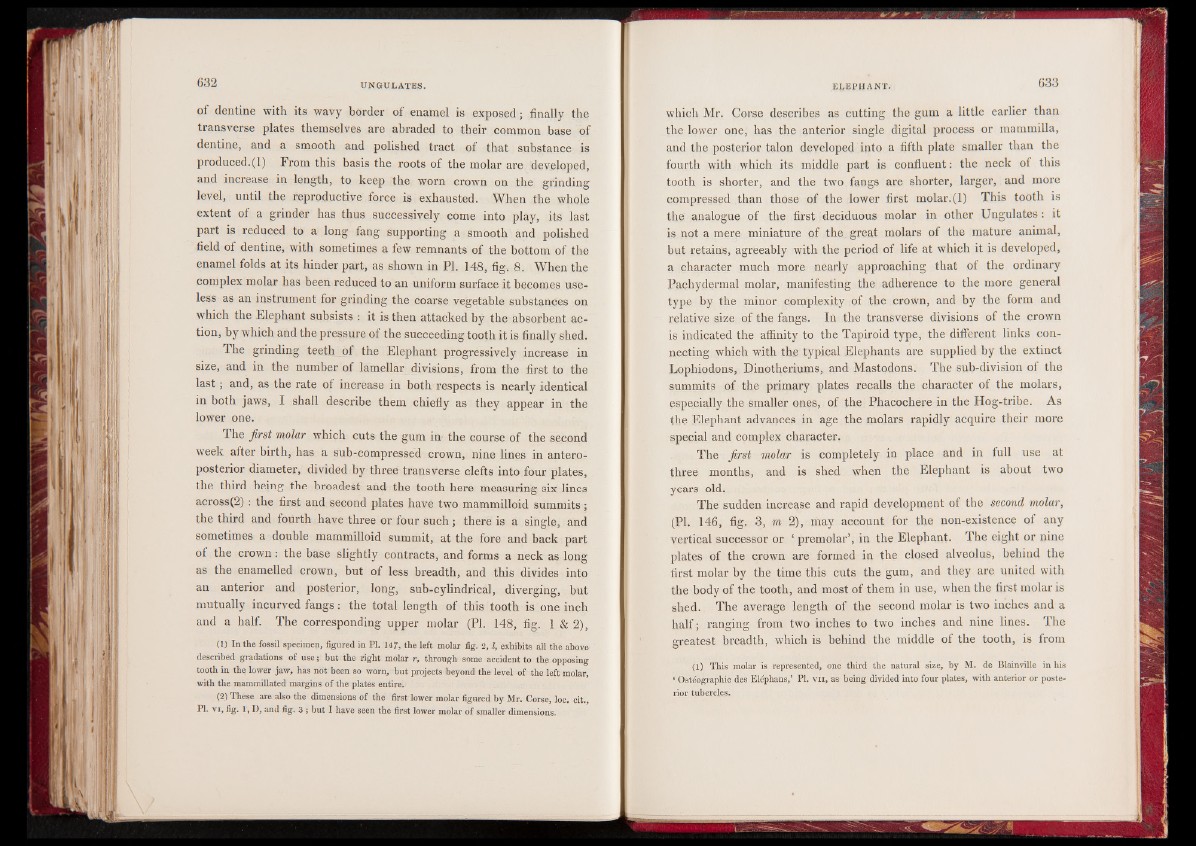
of dentine with its wavy border of enamel is exposed| finally the
transverse plates themselves are abraded to their common base of
dentine, and a smooth and polished tract of that substance is
produced.(1) From this basis the roots of the molar are developed,
and increase in length, to keep the worn crown on the grinding
level, until the reproductive force is exhausted. When the whole
extent of a grinder has thus successively come into play, its last
part is reduced to a long fang supporting a smooth and polished
field of dentine, with sometimes a few remnants of the bottom of the
enamel folds at its hinder part, as shown in PI. 148, fig. 8. When the
complex molar has been reduced to an uniform surface it becomes useless
as an instrument for grinding the coarse vegetable substances on
which the Elephant subsists : it is then attacked by the absorbent action,
by which and the pressure of the succeeding tooth it is finally shed.
The grinding teeth of the Elephant progressively increase in
size, and in the number of lamellar divisions, from the first to the
last; and, as the rate of increase in both respects is nearly identical
in both jaws, I shall describe them chiefly as they appear in the
lower one.
The first molar which cuts the gum in- the course of the second
week after birth, has a sub-compressed crown, nine lines in anteroposterior
diameter, divided by three transverse clefts into four plates,
the third being the broadest and the tooth here measuring six lines
across(2) : the first and second plates have two mammilloid summits;
the third and fourth have three or four such; there is a single, and
sometimes a double mammilloid summit, at the fore and back part
of the crown: the base slightly contracts, and forms a neck as long
as the enamelled crown, but of less breadth, and this divides into
an anterior and posterior, long, sub-cylindrical, diverging, but
mutually incurved fangs: the total length of this tooth is one inch
and a half. The corresponding upper molar (PI. 148, fig. 1 & 2),
(1) In the fossil specimen, figured in PI. 147, the left molar fig. 2, l, exhibits all the above
described gradations of use; but the right molar r, through some accident to the opposing
tooth in the lower jaw, has not been so worn, but projects beyond the level of the left molar,
with the raammiUated margins of the plates entire.
(2) These are also the dimensions of the first lower molar figured by Mr. Corse, loc. cit.,
PI. vi, fig. 1, 0, and fig. 3 j but I have seen the first lower molar of smaller dimensions.
which Mr. Corse describes as cutting the gum a little earlier than
the lower one, has the anterior single digital process or mammilla,
and the posterior talon developed into a fifth plate smaller than the
fourth with which its middle part is confluent: the neck of this
tooth is shorter, and the two fangs are shorter, larger, and more
compressed than those of the lower first molar.(l) This tooth is
the analogue of the first deciduous molar in other Ungulates: it
is not a mere miniature of the great molars of the mature animal,
but retains, agreeably with the period of life at which it is developed,
a character much more nearly approaching that of the ordinary
Pachydermal molar, manifesting the adherence to the more general
type by the minor complexity of the crown, and by the form and
relative size of the fangs. In the transverse divisions of the crown
is indicated the affinity to the Tapiroid type, the different links connecting
which with the typical Elephants are supplied by the extinct
Lophiodons, Dinotheriums, and Mastodons. The sub-division of the
summits of the primary plates recalls the character of the molars,
especially the smaller ones, of the Phacochere in the Hog-tribe. As
the Elephant advances in age the molars rapidly acquire their more
special and complex character,
The first molar is completely in place and in full use at
three months, and is shed when the Elephant is about two
years old.
The sudden increase and rapid development of the second molar,
(PI. 146, fig. 3, m 2), may account for the non-existence of any
vertical successor or ‘ premolar’, in the Elephant. The eight or nine
plates of the crown are formed in the closed alveolus, behind the
first molar by the time this cuts the gum, and they are united with
the body of the tooth, and most of them in use, when the first molar is
shed. The average length of the second molar is two inches and a
half; ranging from two inches to two inches and nine lines. The
greatest breadth, which is behind the middle of the tooth, is from
(l) This molar is represented, one third the natural size, by M. de Blainville in his
‘ Osteographie des Elephans,’ PI. v i i , as being divided into four plates, w ith anterior or posterior
tubercles.